
What causes Mouth Breather Face? Why do people sleep with their mouth open? People who mouth breathe during the day and night almost always develop a mouth breather face. Mouth Breather Face is characterized by poor facial profile and reverse lower jaw position. Proper nasal breathing is one of the most important things for overall health. People who breathe through their nose instead of their mouth are much less likely to suffer from poor mouth breather face, sleep apnea, teeth clenching, poor posture, thyroid problems and bad facial profile. That is just to name a few.
Facial muscle exert pressure on jaw bones during breathing, chewing and swallowing. When people mouth breathe it puts reverse pressure on the mouth and face. Reverse pressure on the jaws in growing kids and adults can cause mouth breather face.
We use a variety of orthodontic expanders to open the nasal passageways and help with better nasal breathing. The tongue is involved in breathing and needs to be trained (with myofunctional therapy) to rest properly on the palate and not be in the bottom part of the mouth and throat. Tongue tie can worsen this condition.
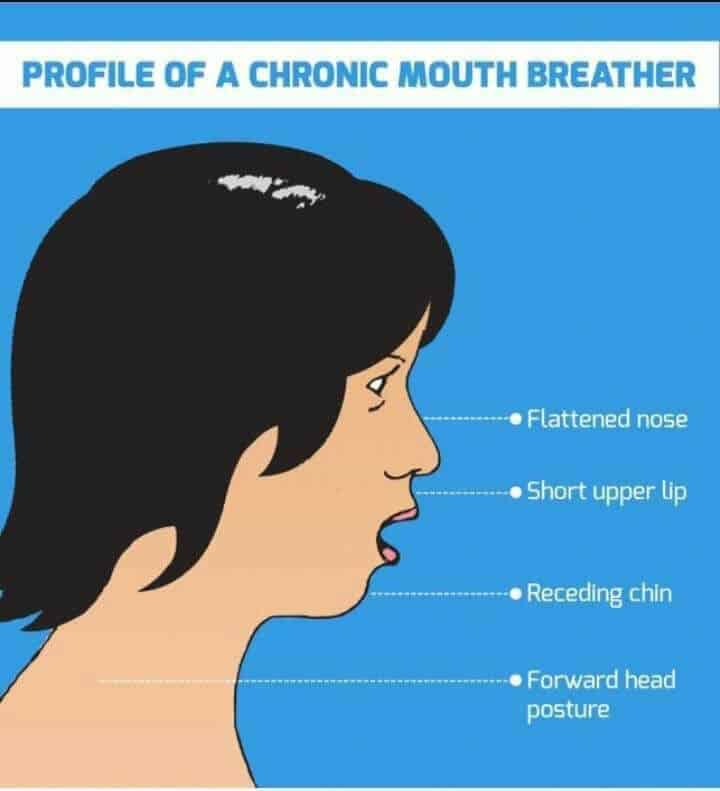
Mouth Breather Face
Our Protocol to Correct Mouth Breather Face
- Orthodontic expanders to enlarge the palate and nasal passageways
- Myofunctional therapy to train palatal tongue posture. Diagnose and release tongue and lip ties when necessary
- Breathe retraining to break the habit of mouth breathing
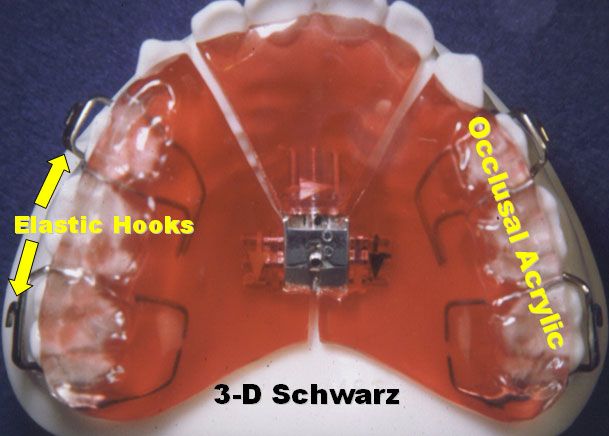
orthodontic palatal expander
What Does Mouth Breather Face Look Like?
- Reverse lower jaw position compared to upper jaw position
- Head posture forward of the shoulders (dowager’s syndrome)
- Forehead large in comparison to the lower part of the face
- Long face that is narrow

mouth breather face2
How to Fix Mouth Breather Face Video
The way to cure mouth breather face is to start nose breathing. But it is more complicated than that. If you are a mouth breather, we can do a lot to help you begin to breath through your nose and stop mouth breathing once and for all. And correct many other problems such as tongue tie, bruxism and sleep and posture problems. The first step in discovering how to stop mouth breathing is to understand what causes people to become a mouth breather to begin with.
If you have not done so, you should read Jame’s Nestor’s Book, “Breath.”
What Causes Mouth Breathing?
Mouth breathing is caused by a deficiency in size of the nasal passageways and poor performance of the tongue and airway. If there is not enough space for air to flow through the nose, than people will need to open the mouth to meet basic oxygen demands. The nose issue is really a matter of space in the nose. It is a structural problem. Orthodontic expanders widen the palate and dramatically improve nose breathing efficiency. The palatal bone (maxilla) is the same as the base of the nose, so palatal expanders is a way to increase the space available for nasal breathing. Sometimes surgery such as nasal turbinate ablation can be necessary. Better surgical results are achieved after the use of expanders. And often surgery is not necessary after maxillary palate expansion.
How to Correct Mouth Breathing
Expanding the palate is not enough to correct mouth breathing. The tongue needs to be strengthened and it’s posture improved into the palate with suction. The muscle tissue in the throat needs to be improved so it is not so “collapsible.” The diaphragm and rib cage muscles need to be strengthened. So to summarize, four areas need to be improved:
- Structures of the jaws and mouth need to be expanded. This can be done with mouth expanders including Vivos devices or Homeoblock appliances.
- The Airway needs to become less collapsible
- Diaphragm and rib cage muscles need to be strengthened with breathing exercises
- Tongue needs to be strengthened and it’s posture improved (myofunctional therapy)
Can Invisalign be used to Treat Mouth Breathing?
Invisalign can be used to improve mouth breathing and that is what this page is all about. Invisalign is the orthodontists best friend in straightening teeth, but, Invisalign can also be used by a knowledgeable dentist to treat mouth breathing, TMJ and some cases of sleep apnea. There are new programs in the Invisalign clear aligner system that can straighten teeth and expand the mouth and jaws at the same time. Expanders create more room in the mouth and nose so the airway spaces are more open for breathing. This naturally helps with nasal breathing and decreases airway resistance and the need for mouth breathing.
Tongue Function is Linked to Mouth Breathing
Mouth breathing is also a consequence of airway obstruction and resistance. This is a bit more complicated to think about. Long-story-short, when the mouth is small and the tongue, tonsils and adenoids are large, there is a tendency for the tongue to fall back into the throat during sleep and get in the way of airflow. Many people only mouth breath at night and not during the day. When the tongue and other tissue gets in the way of airflow during breathing, it creates resistance and makes it more difficult to breathe. This usually happens during deep sleep. During these episodes of sleep disordered breathing, people will open their mouth to breath. The solution to this problem is to create more space in the mouth and again orthodontic expanders are very helpful in stimulating the mouth to grow wider and more forward.
Breathing Exercises and Mouth Taping
Strengthening the muscle tissue in the mouth and airway is also critical. Introducing tongue exercises to strengthen the tongue and improve it’s posture will help it stay up in the palate and not collapse into the throat. Dr. John Mew has a lot of exercises he calls “mewing.” Additionally releasing tongue ties is often necessary to allow it to function better. Breathing exercises and mouth taping will help to break the mouth breathing habit and improve the tone of the muscle in the airway.
Schedule a consultation with Dr. Adams
How to Stop Mouth Breathing
Dr. Adams has a protocol to help people learn to breathe through their nose again. It all starts with an evaluation of your mouth, nasal passageways and tongue. Dr. Adams uses a combination of orthodontic expanders, tongue function correction (myofunctional therapy) and breathing exercises. There are also expanders that work for adults including the Vivos DNA and Homeoblock appliances.
Symptoms of a Mouth Breather:
- Nasal Stuffiness
- Snoring
- Sleep Problems
- Mouth open while sleeping
- Lack of concentration or ADD in kids
- Sinus infections
- Chronic sickness
- Large tonsils and adenoids
- Dark circles under the eyes
- Mouth breather face
Mouth Breathing Compared to Nasal Breathing Video
The Nose Filters Heats and Humidifies Air
As air is inhaled through the nasal membranes dust and dirt are filtered and removed. The air is also heated up and humidified. Air that is hot, clean and humidified is quickly absorbed by the lungs. Nasal breathing also oxygenates the nasal membranes and sinuses. Oxygen kills anaerobic bacteria that cause sinus and nose infections. Oxygen promotes growth of healthy bacteria in the nose and sinuses. In people who nose breathe their immune system works better and they get less bacterial and viral infections.
Mouth Breather Face and Posture
Mouth breather face is basically the effect of what excessive mouth breathing pressure does to the face. People who mouth breath have poor facial profile, small lower jaws and dwarfed looking mouths and droopy lips. Nasal breathing promotes healthy growth and development starting at a very young age. Nose breathing variably uses muscle groups in the ribs, shoulders, neck and face. Healthy coordinated muscle patterns during breathing support good upright comfortable posture.
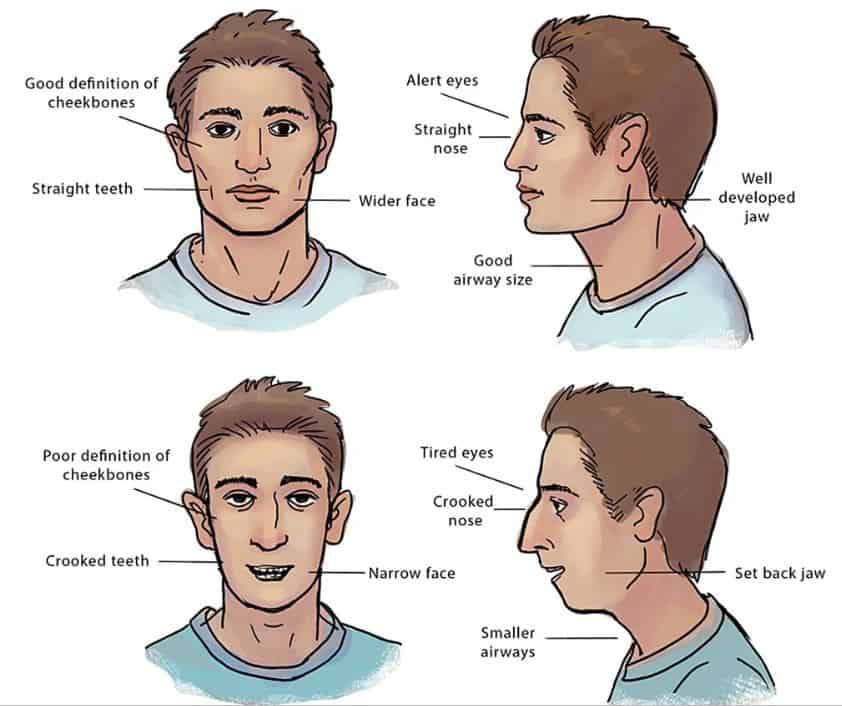
mouth breathing face vs nose breather
How Mouth Breathing Impacts Posture
Mouth breathing uses a different muscle pattern than nasal breathing. Mouth breathing causes people to slouch and have forward head posture. People who mouth breath end up with crooked smiles, poor airways, bad posture, sleep problems and bruxism. This is because muscle patterns used during mouth breathing cause the bones in the face, chest, back and neck to grow to be the wrong size and shape. Muscle pressure stimulates our bones to grow to a certain size and shape.
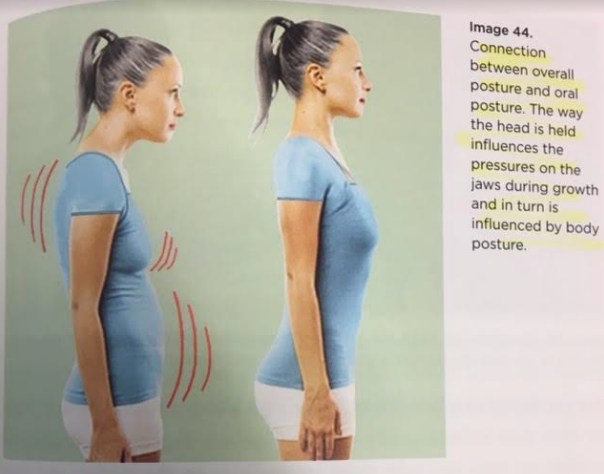
mouth breather posture 3
How to Correct Mouth Breathing Face Video
What is the Root Cause of Mouth Breathing Face?
Poor tongue function at a young age is what creates a mouth breather. The tongue during growth and development applies pressure on the hard palate and the upper teeth. Tongue pressure literally grows the palate wider by pressing on it during swallowing and speech. The palate, a part of the maxillary bone, is the bottom of the nose. When the palate grows wider, people can fit more air through the bigger nasal spaces. If people can get enough oxygen through their nose, they will not open their mouth to breathe. If the nasal passageways are too small people will not get enough oxygen through their nose. They will be forced to open their mouth to get more air. The mouth is a large space.

TongueTie 3
Link Between Mouth Breathing and Tied Tongue
Poor tongue function is most often caused by tied tongue or a condition called ankyloglossia. Tongue tie causes loss of range of motion of the tongue. A tied tongue does not extend our as far and cannot elevate into the palate as easily. Tied tongues often do not spread out as wide and they get pointy and curl down when they are pushed out of the mouth. There is a sequential cause and effect relationship in the following order:
- Tongue Tie
- Poor Tongue Function
- Under Development of the Palate and Nasal Passageways
- Poor Nasal Breathing
- Mouth Breathing
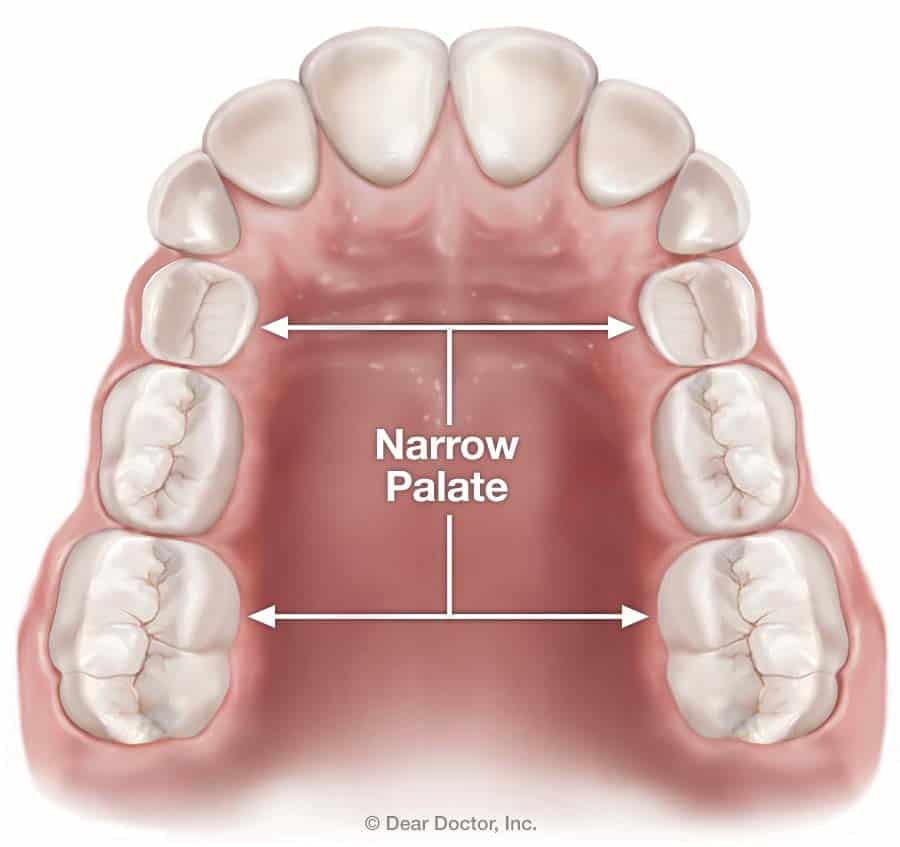
deep narrow palate
Untying the Tongue Assists in Nose Breathing
People who do not have tongue and lip ties and who have healthy tongue function will not be mouth breathers. Reread that again. If you have proper tongue function, you will not be a mouth breather. Ultimately tongue and lip ties cause all upper airway problems during infant and child growth and development. There is a cause and effect relationship between tongue tie, poor tongue function and mouth breathing.
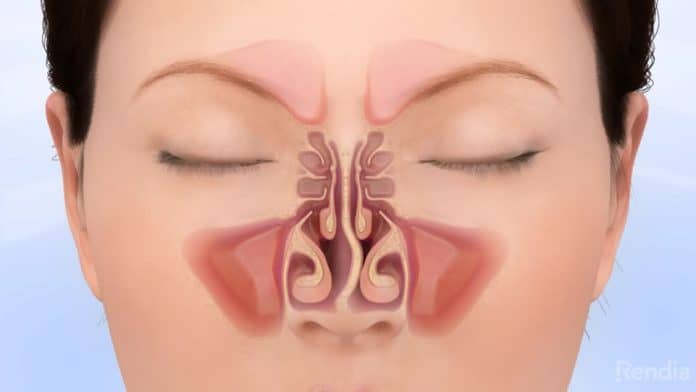
small nasal passage and mouth breathing
How to Treat Tongue Tie
Tongues can be easily untied with the use of a laser and a knowledgeable dentist. It is important to have a tongue untied and proper function verified at the time of the procedure. The dentist should note how the tongue function is deficient. Untie the tongue. And finally verify proper function has been restored. This is called a “functional untie.”
Myofunctional Therapy
Myofunctional therapy is basically physical therapy for tongues. Tongue training and exercises to achieve proper function. Don’t expect the tongue to automatically function perfectly after being untied. When myofunctional therapy is done with a functional untie the rate of reattachment is less than 20%. When tongue untie procedures are not performed in conjunction with the therapy, the reattachment rate is closer to 80%.
How to Treat Mouth Breathers?
- Evaluation Mouth vs Nasal Breathing
- Remove all Tongue and Lip Ties
- Tongue Exercises and Myofunctional Therapy
- Evaluate Facial and Jaw Structures – Design and create orthodontic growth appliances such as palatal expanders
- Evaluate posture and initiate posture restoration with a chiropractor or qualified physical therapist
- Evaluate Breathing patterns and incorporate breathing exercises to restore proper nasal breathing patterns

 (301) 421 1996
(301) 421 1996 burtonsvillesmiles@gmail.com
burtonsvillesmiles@gmail.com